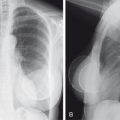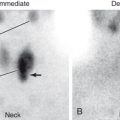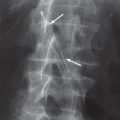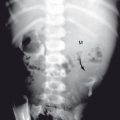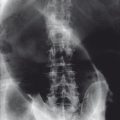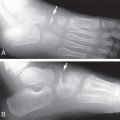Anatomy and Imaging Techniques
The urinary system may be imaged in a number of ways. The initial studies of choice for many suspected clinical problems are shown in Table 7.1 . Historically, the most common radiographic method was intravenous injection of an iodine-based contrast agent followed by a series of radiographs (intravenous pyelogram [IVP]). IVP has been replaced by computed tomography (CT) scanning, with or without intravenous contrast (CT urogram). The normal anatomy is shown in Fig. 7.1 . The other common initial imaging modality is ultrasound.
| Clinical Problem | Imaging Study |
|---|---|
| Acute onset flank pain; suspected ureteral calculus | CT of abdomen and pelvis without contrast |
| Recurrent nephrolithiasis | US with plain x-ray or low-dose CT |
| Gross hematuria (painless) | CT of abdomen and pelvis with and without contrast (CT urography) |
| Hematuria with known renal parenchymal disease | US of kidneys and bladder |
| Microscopic hematuria after recent vigorous exercise, presence of infection, or present or recent menstruation | No imaging recommended |
| Acute pyelonephritis in a complicated patient | CT with and without IV contrast |
| Acute pyelonephritis (uncomplicated) | Imaging not usually appropriate |
| Recurrent urinary tract infection | Cystoscopy; CT if nonresponding or high-risk patient |
| Cystitis (uncomplicated and no underlying risk factors in a female) | No imaging |
| Recurrent lower tract infection (complicated, patients who are nonresponders or have underlying risk factors) | CT of abdomen and pelvis with and without contrast |
| Abscess | CT with and without IV contrast |
| Blunt or penetrating abdominal injury with suspicion of multisystem injury or macroscopic hematuria | CT of abdomen and pelvis with IV contrast |
| Suspected renal mass | CT with and without IV contrast or MRI; if renal insufficiency present, begin with duplex Doppler US |
| Renal cell carcinoma (initial staging) | CT of abdomen with and without contrast and chest x-ray |
| Renal cell carcinoma (follow-up) | Chest x-ray, CT of abdomen and pelvis with contrast (MRI is an alternative) |
| Renal failure (acute or chronic) | US of kidneys and bladder |
| Hydronephrosis | US |
| Renal transplant dysfunction | US with duplex Doppler |
| Obstructive voiding symptoms | US of kidneys and bladder |
| Bladder rupture or pelvic penetrating trauma | CT cystography or x-ray of pelvis and retrograde cystography |
| Urethral obstruction or tear | X-ray of pelvis and x-ray retrograde urethrography |
| Bladder cancer | Cystoscopy, CT with IV contrast for regional and distant disease |
| Suspected renovascular hypertension | CT angiography or MR angiography; if significantly decreased renal function, US of kidneys with duplex Doppler |
| Acute-onset scrotal pain without trauma; suspected testicular torsion | Doppler US |
| Testicular or scrotal mass or trauma | Doppler US |
| Testicular malignancy staging | CT of abdomen and pelvis with contrast and chest x-ray or chest CT with contrast |
| Hematospermia (persistent associated symptoms or age > 40 years) | US of transrectal prostate; imaging not needed for asymptomatic, transient, age < 40 years, with no other symptoms |
| Pelvic or adnexal mass (nonpregnant female) | US of pelvis, transabdominal, Doppler, and/or transvaginal |
| Pelvic pain (female) | US of pelvis, transabdominal and transvaginal; CT of abdomen and pelvis with contrast if nongynecologic cause suspected |
| Cervical cancer | |
| Screening or size < 2 cm | No imaging |
| ≥ 2 cm | MRI with and without contrast |
| Ovarian cancer (screening) | Not recommended for general population |
| Ovarian cancer (high risk or symptoms) | US, transvaginal |
| Endometrial cancer | |
| Low grade | No imaging |
| High grade | MRI or CT |
| Uterine fibroids (initial, enlarging, painful, or bleeding) | Pelvic US |
| Suspected benign prostatic hypertrophy (BPH) | Imaging not recommended unless medications fail or hematuria is present |
| Suspected prostate cancer (no previous biopsy) | PSA measurement and transrectal US (TRUS)-guided biopsy |
| Suspected prostate cancer (negative TRUS biopsy) | Multiparametric MRI of pelvis with and without contrast and MRI-targeted biopsy |
| Prostate cancer (intermediate or high risk) active surveillance | MRI of pelvis, with and without contrast |
| Prostate cancer posttreatment, rising PSA level | NM whole-body bone scan |
| Infertility (female) | No imaging until after physical examination, determination of hormone levels, US for ovarian evaluation, MRI of pelvis for endometriosis, hysterosalpingography for suspected tubal occlusion |
| Pregnancy | |
| Assessment of fetal well-being (low risk pregnancy) | Imaging not indicated |
| Suspected multiple gestation | US |
| Abnormal antenatal testing | US for biophysical profile |
| Acute pelvic pain (female reproductive age group) | US |
| Vaginal bleeding | |
| First trimester | Transabdominal or transvaginal US correlate with β-hCG level |
| Second and third trimesters | Transabdominal US (endovaginal US if inconclusive and no evidence of open cervix, bulging amniotic sac, or ruptured membranes) |
| Premenopausal (first study) | US, transvaginal |
| Postmenopausal (first study) | US, transvaginal |
| Adrenal mass incidentally discovered | See text |

Often, a plain x-ray image of the abdomen (sometimes referred to as a KUB [kidney, ureter, and bladder]) is available. You should examine this carefully, looking for abnormalities in the skeleton, soft tissue margins of the liver, spleen, and psoas regions, the gas pattern in the bowel, and calcifications. Of particular interest are those calcifications that project over or overlie the region where you expect to find the kidneys, ureters, and bladder.
The kidneys should be examined for size, shape, position, and axis. The length of kidneys on a radiographic study is typically about 11 to 13 cm. On an ultrasound examination, they are smaller, only about 10 to 11 cm in length. Intravenous contrast being excreted during a CT examination causes the kidneys to enlarge 1 to 2 cm in length. Normally, the left kidney is somewhat higher than the right; the long axis of the kidneys should be tilted slightly inward, with the superior pole of the kidney being more medial than the lower pole. Look for uniform thickness of the cortex relative to the calyces of the collecting system. The shape of the kidneys should be relatively smooth in outline, although occasionally a slight lump is seen on the lateral margin of the kidneys. The lateral lump is sometimes referred to as a dromedary hump or column of Bertin. Although this is a common variant, you cannot exclude a cyst or neoplasm if a major difference is found between the thickness of the cortex between the calyces and the outer margin of the kidney or if one portion of the cortex is focally thicker than another. Often a renal ultrasound is the most cost-efficient and innocuous way of resolving this problem.
On the CT scan, a dark area normally surrounds the collecting system of the kidneys, which represents fat in the hilum of the kidney. Look carefully at the calyces to make sure that they are sharp and pointed, not blunted, at their outer corners, and examine the renal pelvis and ureters for any intrinsic or extrinsic defects. The ureters should course inferiorly and medially from the kidneys and anterior to the psoas muscles at the L3 to L5 level. On the anteroposterior projection, the ureters typically are most medial and project over the lateral aspect of the transverse processes at L3, L4, and L5. As the ureters pass over the sacrum, they deviate laterally and then enter the bladder from the posterolateral aspect.
Renal ultrasound is a simple, noninvasive examination ( Fig. 7.2 ). Remember that all ultrasound images are referred to as slices and that the easiest view of the kidney to understand is the longitudinal view. The right kidney is easily visualized by transmitting sound through the right lobe of the liver. Because bowel and stomach gas prevents ultrasound transmission, the left kidney is usually visualized from the patient’s back. The kidney is bean-shaped and has bright central echoes because of the fat surrounding the collecting system. Ultrasound is typically ordered to exclude hydronephrosis or evaluate renal size or suspected renal cysts.

CT is often used as the initial imaging test for suspected renal cell carcinoma, complicated renal or ureteral stones, or trauma. Magnetic resonance imaging (MRI) or CT may be used in cases of renal cell carcinoma to exclude renal vein or inferior vena cava thrombus. Nuclear medicine techniques are used when function or other parameters must be quantitated. Indications for radioisotope techniques include the evaluation to determine whether a dilated collecting system is obstructive or nonobstructive and to detect renovascular hypertension.
Intravenous contrast medium is heavier than urine and layers posteriorly in the bladder when the patient is supine. The anterior and lateral bladder walls are usually not well seen. Consequently, if you wish to see the entire internal surface of the bladder, a Foley catheter can be placed directly into the bladder, the urine drained, and the bladder refilled with contrast material. This procedure is called a cystogram . On a cystogram, images of the bladder are obtained in several different projections. A cystogram can also be performed with CT. When the catheter is removed, the patient may be asked to void, and fluoroscopic images are then taken. In male patients, this gives a good demonstration of the urethra ( Fig. 7.3 ). The male urethra also can be studied in a retrograde fashion by inserting a small tube in the tip of the penis and injecting the contrast material. This is usually done only in cases of suspected urethral trauma or stricture.

Kidneys
Congenital Abnormalities
Congenital abnormalities of the urinary tract occur quite frequently, and you should be aware of the most common variants. Embryologically, the ureter buds and grows superiorly from the bladder to meet and connect with the renal parenchyma. The ureter can divide as it ascends, causing a person to have two partially duplicated or completely separate collecting systems for one kidney. If complete ureteral duplication is found, the ureter that supplies the upper half of the kidney often becomes obstructed ( Fig. 7.4 ). If the upper pole of the kidney is completely obstructed, all that is visualized is the normally draining lower pole collecting system, and it looks like a drooping lily. You should also be aware that the duplicated ureter that supplies the upper pole may often have an ectopic insertion into the bladder, urethra, or vagina.

A number of other anomalies occur in the course of the normal embryologic ascent of the kidneys out of the bony pelvis. These anomalies include one kidney rising normally and the other kidney remaining in the pelvis. Remember, it is rare to have a unilateral kidney, and thus if you see only one kidney in its normal position, you should look elsewhere for an ectopic kidney ( Fig. 7.5 ). Another common variant is fusion of the inferior aspect of both kidneys (a horseshoe kidney). This is relatively easy to identify because the axis of the kidneys is abnormal, with the superior aspect of the kidneys tilted outward instead of inward ( Fig. 7.6 ).


Renal Cysts
Renal cysts are quite common, and their incidence increases with age. Most persons older than 60 years have one or more simple renal cysts. These are often found incidentally on ultrasound or CT scans ordered for other reasons. Ultrasound is a good and inexpensive initial test to characterize a renal cyst. The margins of a benign simple cyst should be well defined, and increased echoes should be seen on the posterior aspect of the cyst because of good transmission of sound through the fluid in the cyst ( Fig. 7.7A ). If a cyst has septa or internal echoes on ultrasound, a short-term follow-up ultrasound or CT scan is usually ordered to exclude a cystic neoplasm.

On a CT scan, renal cysts are typically hypodense relative to the renal parenchyma; however, occasionally they can be hyperdense due to blood or protein content (see Fig. 7.7B ). Hyperdense renal cysts should not enhance more than about 10 Hounsfield units after contrast administration and should have a smooth outline and be internally homogeneous.
Currently renal cysts or cystic masses are classified according to the Bosniak criteria. Bosniak I lesions are benign cysts that are round or oval with a thin wall, no septations, Hounsfield CT units of 0 to 20, and no enhancement with intravenous contrast. Follow-up is not usually needed. Bosniak II lesions are the same but with a few septations, a few thin calcifications, or both. These are often followed up in 6 to 12 months, but both Bosniak I and II lesions have a very small chance of being malignant. A Bosniak III lesion has any or all of the following: a thick wall, calcifications, Hounsfield density of 0 to 20, and no enhancement of nodules. These lesions have about a 60% chance of being malignant. Bosniak IV lesions have a thick wall, thick septations, coarse calcifications, Hounsfield density of more than 20, and enhancement with intravenous contrast. All these lesions should be considered to be malignant and require further workup.
Polycystic renal disease presents a difficult imaging problem. In the adult form of this heritable disorder, often progressive renal failure occurs. A CT scan will demonstrate very lumpy kidneys, but the cysts may not be well defined because hemorrhage often is found within the cyst. Cysts also are usually identified in the liver and sometimes in the pancreas ( Fig. 7.8 ).

Hematuria
Hematuria can be traumatic or nontraumatic and visible or microscopic. Microscopic hematuria is defined as three or more red blood cells (RBCs) per high-power field (HPF) on microscopic evaluation of urinary sediment from two of three properly collected urine specimens. In cases of trauma and visible hematuria, a CT scan is indicated. In cases of trauma, microscopic hematuria, and little suspicion of injury to other organs, many physicians do not do any imaging but rather wait 48 hours to see if the hematuria clears. Young women with a clinical picture of simple cystitis and other patients whose microscopic hematuria completely and permanently resolves after rest or therapy are unlikely to benefit from imaging.
Of patients with nontraumatic visible hematuria, about 25% have cancer, 25% have infection, and 15% have calculi. About 5% of patients with nontraumatic microscopic hematuria (5 RBCs/HPF) have a urologic cancer. Obviously, the presence of unilateral flank pain suggests calculi, discussed later. If RBC casts are seen in urine with associated proteinuria, a renal biopsy is usually performed. Neither CT nor an ultrasound examination can completely exclude a urologic malignancy because CT and ultrasound are poor for detection of small urothelial tumors and evaluation of bladder tumors. The best evaluation of painless nontraumatic hematuria often begins with cystoscopy and possibly retrograde pyelogram at the same time. If this is negative, a CT scan is indicated.
Renal Stone Disease
Calcification can occur within the substance of the kidney or within the collecting system. Calcification within the substance of the kidney (nephrocalcinosis) may be cortical (near the periphery of the kidney) or medullary (near the ends of the calyces). Cortical calcification can be due to chronic glomerulonephritis, cortical necrosis, or acquired immunodeficiency syndrome (AIDS)-related nephropathy. Medullary calcification may be idiopathic or caused by papillary necrosis, medullary sponge kidney, or other hypercalcemic states (including hyperparathyroidism and osteoporosis; Fig. 7.9 ).

The vast majority of renal calculi are radiopaque and appear dense (or white) on a routine x-ray ( Fig. 7.10A ). Occasionally, renal stones become very large and essentially fill the collecting system of the kidney. These are referred to as staghorn calculi (see Fig. 7.10B ). If calculi are radiopaque, overlie the kidneys, or are within the course of a ureter, they are usually fairly easy to see. Sometimes it can be difficult to visualize a small stone in the region where the ureter passes anterior to the sacrum. Remember that a large number of vascular calcifications occur low within the bony pelvis and to the sides of the bladder. These phleboliths typically can be recognized because they are round, have a lucent (dark) center, and are more lateral and lower in the pelvis than the normal course of the ureter.

The most common clinical presentation of stone disease is intense flank pain with hematuria. If the patient is having a first presentation of renal stone disease, a spiral noncontrast CT scan is indicated, even if no calculus is seen on the plain x-ray of the abdomen. Only about 50% of renal calculi are seen on a plain film, whereas detection with CT is about 95%. CT scanning is exquisitely sensitive for the detection of even tiny calcifications and provides additional detail about other potential causes of pain, and the size of the stone can be accurately measured. Ultrasound can visualize large renal stones and hydronephrosis but is poor for the detection of small renal or any size ureteral stones ( Fig. 7.11 ).

If a history of renal stones is known, imaging is not always needed. Imaging may be reserved for patients who have pain uncontrolled by medication, those with continued flank pain for more than 5 days, those who have continued hematuria 2 weeks after passing a stone, those with microscopic hematuria for more than 1 month, and those who have acute flank pain and are known to have a solitary kidney or pelvic tumor.
The size of a stone is inversely proportional to its passage. A stone 5 mm or smaller has a 68% probability of spontaneous passage, whereas a 10-mm stone is very unlikely to pass spontaneously. Stones typically become lodged in the ureter at the ureteropelvic junction, iliac vessels, or ureterovesicular junction.
On a CT urogram, obstruction of the ureter by a stone may cause delayed visualization of the affected kidney and ureter. When it is visualized, the ureter is usually dilated and the renal calyces are blunted. On delayed images, whereas the normal kidney is completely clear of contrast, the affected kidney and ureter will be seen retaining contrast. Delayed images are often necessary to determine the exact level of the ureteral obstruction.
Usually a kidney with an acute problem due to renal calculi will have associated perirenal edema in the adjacent soft tissues ( Fig. 7.12A ). Benign age-related perinephric stranding is usually bilateral and occurs mostly in persons older than 55 years. If a stone is lodged in the distal ureter, a dilated proximal ureter can often be seen (see Fig. 7.12B ). Sometimes on a CT scan it is difficult to differentiate ureteral calculi from atherosclerotic vascular calcifications or vascular phleboliths. One way is to look for a soft tissue rim around the calculus (see Fig. 7.12C ). Phleboliths are most common in the lower pelvis below the middle portion of the femoral heads, whereas the ureters almost always enter the bladder at a more cephalad level.

Occasionally, the back pressure caused by an obstructing ureteral stone can rupture a renal calyx or renal pelvis. When this occurs, extravasation of urine and contrast outside the kidney into the perirenal space is seen. When an obstructing lesion of the ureter is present, the urologist may perform cystoscopy and then place a little tube into the distal ureter and inject contrast (retrograde pyelogram). The ureter, renal pelvis, and calyces are usually visualized. Because pressure is being exerted during the injection, minimal blunting of the calyces is normal under these circumstances. A retrograde pyelogram is useful for looking at small lesions within the collecting system, such as a transitional cell carcinoma. Occasionally, air bubbles will be inadvertently injected along with the contrast, which may give the appearance of filling defects. The key to differentiating these entities is that tumors will not move around on different views; many calculi also have sharp or geometric borders ( Fig. 7.13 ). Air bubbles move and are completely round.

Renal Failure
Imaging is indicated in patients with unexplained oliguria or new onset of renal insufficiency or failure (serum creatinine level > 2 mg/dL). Many imaging studies of the kidneys rely on normal function. The most common clinical question is whether renal failure is due to obstruction or to medical renal disease. Because the intravenous contrast material used for a CT or MRI scan can reduce renal function, the imaging examination of choice for acute or chronic renal insufficiency is ultrasonography. Normally, the cortex of the kidney has the same ultrasound echo density as the liver or has fewer echoes than the substance of the liver. In cases of medical renal disease, more echoes are found within the renal cortex than within the liver. This is probably the result of fibrosis and scarring ( Fig. 7.14 ). For the use of intravenous contrast with a CT or MRI scan, an estimated glomerular filtration rate (eGFR) of 60 mL/min per 1.73 m 2 or greater is acceptable, an eGFR of 30 to 60 mL/min per 1.73 m 2 usually requires hydration of the patient, and a value of less than 30 mL/min per 1.73 m 2 is a significant contraindication.

Pyelonephritis and Renal Infections
The clinical findings of pyelonephritis include fever, flank pain, and pyuria. Most patients with pyelonephritis have no discernible findings on imaging studies. Imaging studies are usually not warranted in an uncomplicated patient unless there are repetitive episodes or there is persistent worsening pain after 3 days of appropriate antibiotic therapy. CT scanning with and without intravenous contrast is appropriate in patients who are complicated (e.g., have diabetes, are immunocompromised, had prior renal surgery or history of stones). Sometimes, in patients who have severe acute pyelonephritis, enough edema of the renal parenchyma is present that the swelling causes compression of the calyces or renal pelvis, and there is poor visualization of the collecting system on a CT urogram. Occasionally, with acute pyelonephritis, focal areas of edema can be seen. The real purpose of ordering CT scans in these cases should be to look for a renal parenchymal or perirenal abscess.
In patients with chronic pyelonephritis, the kidney is usually shrunken and has an irregular outer margin. Typically, the cortex also is thinned. The irregularities of the outer cortical margin are fairly characteristic, with dimpling or scarring directly over a calyx. If there is dimpling or a defect in the margin of the kidney between two calyces, it is more likely to be the result of a focal infarct.
Persons with diabetes are particularly prone to an unusual form of acute pyelonephritis called emphysematous pyelonephritis . In these patients, gas is generated by the bacteria within the parenchyma of the kidney. Usually the kidney is nonfunctional, and a dark radiating striated gas pattern is seen where you would normally expect to find a kidney ( Fig. 7.15 ).

Occasionally, inflammatory abnormalities can cause enlargement of both kidneys, particularly in acute glomerulonephritis. The differential diagnosis for bilaterally enlarged kidneys includes bilateral obstruction, leukemia, glycogen storage diseases, lymphoma, and polycystic disease, as well as a number of other entities ( Fig. 7.16 ).

Infections of the kidney can progress to the stage at which the kidney is essentially nonfunctional. In an entity known as xanthogranulomatous pyelonephritis , a nonfunctional kidney is seen, with some calcification visible within it ( Fig. 7.17 ). The kidney is removed surgically. However, on the basis of any imaging study, it is difficult to differentiate xanthogranulomatous pyelonephritis from a renal tumor.

Renal tuberculosis can affect the kidneys, ureter, and bladder; the infection typically begins in the kidneys, and you should look there first. In the early stages, narrowing or amputation of the infundibulum is seen between a renal calyx and the renal pelvis. In late stages, a nonfunctional shrunken kidney with clumps of calcification is found. A number of fungal infections can affect the kidney in diabetic and immunosuppressed patients. Fungal infections often cause large fungal clumps or balls within the collecting system that can obstruct the kidney ( Fig. 7.18 ).


